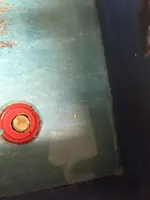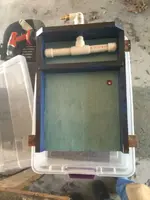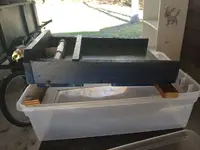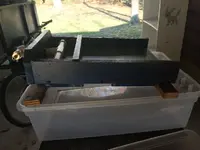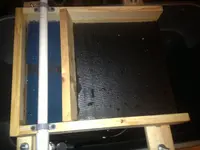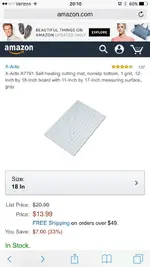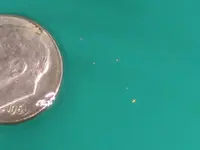You are using an out of date browser. It may not display this or other websites correctly.
You should upgrade or use an alternative browser.
You should upgrade or use an alternative browser.
Made my own Miller table
- Thread starter flyadive
- Start date
- #4
Thread Owner
Did you get that speak I mean speck in NJ?
No, I gots it from purchased paydirt. I'm still practicing.
goldenmojo
Bronze Member
- Joined
- Dec 9, 2013
- Messages
- 1,869
- Reaction score
- 4,768
- Golden Thread
- 0
- Location
- N. California
- Detector(s) used
- Bazooka Prospector-Sniper-Supermini Thanks Todd & Chris, Goldhog Multisluice Thanks Doc, My Land Matters Thanks Claydiggins, 6 Senses
- Primary Interest:
- Prospecting
Pyrofx
Jr. Member
- Joined
- Jan 7, 2016
- Messages
- 25
- Reaction score
- 44
- Golden Thread
- 0
- Location
- Needles Ca
- Detector(s) used
- Goldbug 2 keene a52, GOLD HOG RIVER SLUICE, home built 6 x 60 recirc high banker, Gold cube, Miller table....and a pan or two
- Primary Interest:
- All Treasure Hunting
The gasket material is too hard and slick, for $12 you can get a self-repairing cutting mat from a hobby shop. I have made a few now and they work excellent
- #8
Thread Owner
kcm
Gold Member
- Joined
- Feb 29, 2016
- Messages
- 5,790
- Reaction score
- 7,090
- Golden Thread
- 0
- Location
- NW Minnesota
- Detector(s) used
- Tesoro Silver uMax
- Primary Interest:
- Other
That would be it. Like was mentioned before, you would also scuff up what you're using now. Just make sure to scuff side-to-side only, using a coarse sandpaper. Doing this will make teeny tiny riffles that will help catch the heavies. As all of your material is classified down very small, this should work very well.
goldenmojo
Bronze Member
- Joined
- Dec 9, 2013
- Messages
- 1,869
- Reaction score
- 4,768
- Golden Thread
- 0
- Location
- N. California
- Detector(s) used
- Bazooka Prospector-Sniper-Supermini Thanks Todd & Chris, Goldhog Multisluice Thanks Doc, My Land Matters Thanks Claydiggins, 6 Senses
- Primary Interest:
- Prospecting
I got a slightly textured mat at harbor freight for $3. It was tool box liner I think 18 x 18. It is soft enough when it is wet that I take the artist brush I use to move the sands around with and use the handle to press and pull a line crossways near the top of the flow next to the wall. I then scrape my gold into that slot which lasts for about twenty minutes and then the mat reforms.
- Joined
- Jan 6, 2014
- Messages
- 15,230
- Reaction score
- 57,357
- Golden Thread
- 0
- Location
- Brookings-Harbor Oregon
- Detector(s) used
- White's prizm IV
Keene A52 with Gold Hog mats
Gold-N-Sand hand dredge
- Primary Interest:
- All Treasure Hunting
If using chalkboard paint...should you "scuff" up the surface?
And, does it matter if it is wood, aluminum (sluice box blank) or ABS? (which I can't find...)
And, does it matter if it is wood, aluminum (sluice box blank) or ABS? (which I can't find...)
kcm
Gold Member
- Joined
- Feb 29, 2016
- Messages
- 5,790
- Reaction score
- 7,090
- Golden Thread
- 0
- Location
- NW Minnesota
- Detector(s) used
- Tesoro Silver uMax
- Primary Interest:
- Other
Wood was good in the old days, but they had nothing else. Now there are MUCH better materials. In the end it's what you will accept for your project and how much $$ you're willing to invest. It need not be expensive to work great!
arizau
Silver Member
If using chalkboard paint...should you "scuff" up the surface?
And, does it matter if it is wood, aluminum (sluice box blank) or ABS? (which I can't find...)
Chalkboard paint dries to a rough to the touch texture (sort of like already used sandpaper). It probably adheres better to wood but wood raises when wet as the individual fibers absorb water and expand. I think the first miller tables were just made of well sanded wood and took advantage of the fact that, when wet, the fibers still expanded microscopically and created just enough drag to allow the table to work well. As a side note; a common woodworking practice is to first sand then lightly wet and let dry and then resand to smooth off the now slightly raised wood fibers before applying the finish coats.
Last edited:
Capt Nemo
Bronze Member
- Joined
- Apr 11, 2015
- Messages
- 1,058
- Reaction score
- 1,611
- Golden Thread
- 0
- Location
- Oshkosh, WI
- Primary Interest:
- All Treasure Hunting
If scuffing a cutting mat, use 400 grit as a minimum! 220 grit will make heavy scrapes that you may not be able to brush the gold out of.
6500 deg (daylight) LED clamp lights work great for making gold "POP" on the table. I now run 2 on my table. (available at Lowe's ~$19 ea) I may try LED strips on the sides of my next table. Cross lighting from the sides really helps to spot the tiniest specks.
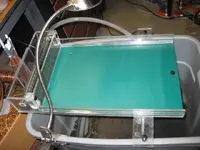
6500 deg (daylight) LED clamp lights work great for making gold "POP" on the table. I now run 2 on my table. (available at Lowe's ~$19 ea) I may try LED strips on the sides of my next table. Cross lighting from the sides really helps to spot the tiniest specks.

russau
Gold Member
- Joined
- May 29, 2005
- Messages
- 7,882
- Reaction score
- 7,785
- Golden Thread
- 0
- Location
- St. Louis, missouri
that's a nice tip! Ill have to try that on my table.
Capt Nemo
Bronze Member
- Joined
- Apr 11, 2015
- Messages
- 1,058
- Reaction score
- 1,611
- Golden Thread
- 0
- Location
- Oshkosh, WI
- Primary Interest:
- All Treasure Hunting
desert-rat
Full Member
- Joined
- Nov 15, 2015
- Messages
- 123
- Reaction score
- 103
- Golden Thread
- 0
- Location
- western arizona
- Primary Interest:
- Prospecting
might run a wire brush over that gralock if its the type im thinking it is from the pictures it will grove it up pretty good.
Bonaro
Hero Member
- Joined
- Aug 9, 2004
- Messages
- 977
- Reaction score
- 2,213
- Golden Thread
- 0
- Location
- Olympia WA
- Detector(s) used
- Minelab Xterra 70, Minelab SD 2200d, 2.5", 3", 4"and several Keene 5" production dredges, Knelson Centrifuge, Gold screw automatic panner
- Primary Interest:
- Prospecting
The gasket material (assuming it is what I am imagining) has a waxy surface. This is by design to help seal water jackets but it is not what you want for a table as it will repel gold.
One of the best and cheapest materials I have found is a section out of a old school neoprene wetsuit. The smooth black rubbery ones, not the cloth lined ones. Available at most any thrift store for cheap. This is the same type material used in a Black Magic cleanup sluice.
Another trick with this is to find or make sort of a riffle tray for it like it were a regular sluice but wit about 1" spacing. Store the table with the riffles lying on the neoprene with a bit if weight. When you take it out to use it, remove the riffle tray and set it aside. It will have left some indentations in the neoprene that work like tiny drop riffles. The neoprene has a memory and the indentations will last for several hours before the rubber relaxes and becomes smooth again.
One of the best and cheapest materials I have found is a section out of a old school neoprene wetsuit. The smooth black rubbery ones, not the cloth lined ones. Available at most any thrift store for cheap. This is the same type material used in a Black Magic cleanup sluice.
Another trick with this is to find or make sort of a riffle tray for it like it were a regular sluice but wit about 1" spacing. Store the table with the riffles lying on the neoprene with a bit if weight. When you take it out to use it, remove the riffle tray and set it aside. It will have left some indentations in the neoprene that work like tiny drop riffles. The neoprene has a memory and the indentations will last for several hours before the rubber relaxes and becomes smooth again.
GoldpannerDave
Bronze Member
- Joined
- Apr 17, 2014
- Messages
- 1,076
- Reaction score
- 1,279
- Golden Thread
- 0
- Location
- Colorado Springs, CO
- Detector(s) used
- Bazooka 48" Miner and 30" Sniper, Le Trap, Wolf Trap, A52, 2" dredge, Miller tables, Blue Bowl, wheel, Falcon MD20, old White's detector
- Primary Interest:
- Prospecting
The gasket material is too hard and slick, for $12 you can get a self-repairing cutting mat from a hobby shop. I have made a few now and they work excellent
The shelf covering azviper used in his plans is also a great surface for a Miller table. And it is cheap; and needs no special roughing up, etc. See Azviper's plans.
No gold in NY
Bronze Member
- Joined
- Mar 22, 2015
- Messages
- 1,688
- Reaction score
- 2,921
- Golden Thread
- 0
- Detector(s) used
- Whites Coin Master,
Whites Gold Master GMT, Whites MXSport
High banker/dredge,
DIY hand trommel,
DIY Miller table,
DIY fluidbed gold trap sluice,
Keene A-52 A-52s
2186 Wheaties
- Primary Interest:
- Other
You can check out AZviper's plans using the rubber mat here...http://www.treasurenet.com/forums/g...ng-miller-table-using-rubber-mat-surface.html.
The scotchbrite does a great job of smoothing the water and removing bubbles. As a bonus, it traps a lot of fine dirt. You do not want to run dirt through your pump. My water recirculating system runs through three sediment traps before returning to the pump. I am going to check out the clamp on LED lamp even though overhear florescent lights seem to work well.
The scotchbrite does a great job of smoothing the water and removing bubbles. As a bonus, it traps a lot of fine dirt. You do not want to run dirt through your pump. My water recirculating system runs through three sediment traps before returning to the pump. I am going to check out the clamp on LED lamp even though overhear florescent lights seem to work well.
Similar threads
- Replies
- 24
- Views
- 3K
Users who are viewing this thread
Total: 1 (members: 0, guests: 1)

